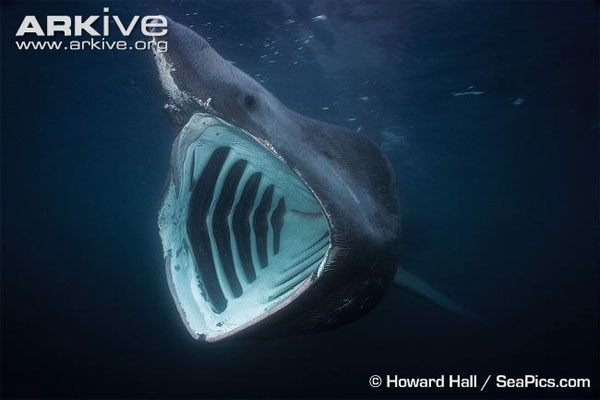Learn about giant sharks with monstrous bodies
Scientists have deciphered the 50-year-old mystery of the shelter of exposed sharks. Accordingly, dried sharks have migrated very far in winter, down to a depth of 200 to 1000 meters in the tropical region of the Atlantic. That explains the mysterious disappearance of this giant fish from their familiar waters throughout the long winter.
This shark is called "sun-dried shark" because it is often observed when eating on the surface and seems to be exposed to warm water. Sunfish are a coastal fish found throughout the world. . It enjoys temperatures of 8-14.5 ° C (46-58 ° F), but has recently been confirmed to pass much warmer waters, at the equator. It is often seen near the beach, including the fjord.

Sunfish shark is found from a depth of at least 910m. Its length can be up to 12.27m (40.3ft), and it weighs about 19 tons. On average, adults reach 6–8m (20–26 ft) in length and weigh about 5.2 tons. They are very special in shape with their cones, large and pointed snout, dorsal and chest fins can be up to 2 meters long.
Sharks eat passively, just by swimming and opening their mouths. When water passes through the gills, plankton are kept; A fairly large shark can filter about 1,500 cubic meters of water per hour.

Sharks are separate reproductive animals in the herd, usually in small quantities (3 or 4), but can also be up to 100 individuals. They are thought to work on visual signals. Although the sun rays' eyes are small, they are fully developed.
This species suddenly disappears from the coastal waters during the winter months and it has been hypothesized that they "hibernate" in deep water. Recently, scientists have deciphered the 50-year-old mystery of the habitat of exposed sharks (basking shark - Cetorhinus maximus) in the western Atlantic, their results published in Recent issue of Current Biology magazine.

Lead researcher Gregory Skomal said: 'Although it often floats in the summer and autumn, the disappearance of winter sharks is the most controversial topic since 1954 with the assumption that they are 'dormant' on the ocean floor at this time '. Skomal and his colleagues solved this mystery based on satellite positioning techniques. Scientists marked 25 sharks with satellite transmitters that automatically signaled 18 times in a cycle of 12 to 423 days.

Through the study of sent signals, the authors found that dried sharks have migrated very far in winter, down to a depth of 200 to 1000 meters in the tropical region of the Atlantic. This migration, along with the depth to which they move, explains why in winter, dried sharks were not discovered in their activity areas for a long time.

The authors conclude: 'Our results have an important meaning in conservation because tropical waters are no longer considered a barrier for exposed shark groups. International cooperation on conservation is therefore capable of restoring the number of sharks exposed across the entire range of species' distribution.
- Terrifying to the incredible weird sharks
- Herds of 1,400 dried sharks make the experts confused
- The fiends in the shark world
- Giant white sharks eat more than people think
- Hammerhead sharks - one of the weirdest sharks in the world
- Heroes of giant sharks circling the group of rowers
- Australia caught rare giant sharks after more than 80 years
- Close up of sharks tearing the giant whale in the middle of the surfing area
- Catching the biggest 'monster' shark in England, could not pull on the boat
- Find the mystery that makes the world's largest shark disappear
- Giant reptiles used to be the food of ancient sharks
- Giant sharks appear next to Trump billionaire golf course
 Surprised: Fish that live in the dark ocean still see colors
Surprised: Fish that live in the dark ocean still see colors Japan suddenly caught the creature that caused the earthquake in the legend
Japan suddenly caught the creature that caused the earthquake in the legend A series of gray whale carcasses washed ashore on California's coast
A series of gray whale carcasses washed ashore on California's coast Compare the size of shark species in the world
Compare the size of shark species in the world